Embark on a walking tour through Rome’s Baroque splendor, where art history comes alive on the streets of the Eternal City. This Baroque Art & Architecture itinerary is tailored for art enthusiasts and cultural travelers, guiding you through ornate piazzas and church interiors that burst with theatrical artistry. You’ll explore the era’s defining masterpieces – from Bernini’s dynamic sculptures to Caravaggio’s dramatic canvases – all while learning the stories behind each marvel. Get ready to traverse cobbled streets and gilded halls on a journey that highlights the beauty, drama, and grandeur of Baroque architecture in Rome.
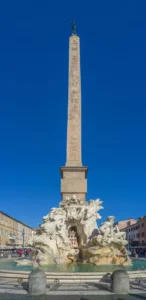
Piazza Navona – Bernini & Borromini’s Baroque Showdown:
We begin at Piazza Navona, one of Rome’s most beautiful squares, showcasing a friendly rivalry between two Baroque masters. At the center stands Gian Lorenzo Bernini’s Fontana dei Quattro Fiumi (Fountain of the Four Rivers), an elaborate 1651 fountain featuring giant marble river gods supporting an ancient obelisk. Surrounding the fountain’s base, you’ll spot personifications of the Nile, Danube, Ganges, and Río de la Plata – symbols of continents touched by papal influence. Across the piazza is Sant’Agnese in Agone, a church with a facade by Francesco Borromini, whose concave design elegantly frames the square. Together, Bernini’s theatrical fountain and Borromini’s harmonious church frontage epitomize the Baroque flair for drama and movement in architecture. You’ll learn how Pope Innocent X commissioned these works, unwittingly pitting Bernini and Borromini’s talents against each other in a Baroque architectural duel.
Bernini’s spectacular Fontana dei Quattro Fiumi (Fountain of the Four Rivers) anchors Piazza Navona, facing Borromini’s Sant’Agnese in Agone. This iconic fountain (designed in 1651) dramatizes four great rivers of the world, showcasing the theatricality of Baroque art.
Sant’Agostino – Caravaggio’s Pilgrim Madonna:
A short stroll away, we visit the Church of Sant’Agostino, an early Renaissance church with Baroque surprises inside. Here you’ll find Caravaggio’s Madonna di Loreto (Pilgrim’s Madonna) in the Cavalletti Chapel, one of Rome’s hidden artistic gems. This striking painting depicts the Virgin Mary with baby Jesus appearing to two humble pilgrims – their feet dusty from travel – illustrating Caravaggio’s trademark realism and chiaroscuro. As you admire the canvas in the soft chapel light, our guide will explain how Caravaggio shook the art world by using ordinary people as models for sacred figures, bringing a raw humanity to Baroque art. Sant’Agostino’s serene architecture and its collection of Baroque paintings (including works by Raphael and Guido Reni) set the stage for the drama to come. It’s a fitting introduction to how Baroque art blended everyday emotion with spiritual grandeur.
San Luigi dei Francesi – Caravaggio’s St. Matthew Cycle:
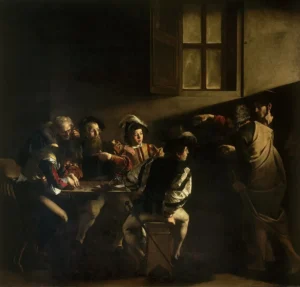
Tucked between bustling Roman lanes, the Church of San Luigi dei Francesi houses three of Caravaggio’s most famous paintings. In the Contarelli Chapel, you’ll stand before the St. Matthew cycle – The Calling of St. Matthew, The Martyrdom of St. Matthew, and St. Matthew and the Angel. These masterpieces, commissioned around 1600, demonstrate Caravaggio’s revolutionary use of light and shadow. Watch as a beam of light seems to burst from the canvas in The Calling, illuminating the astonished face of Matthew the tax collector as Christ summons him. In these works, dark tavern settings and dramatic gestures create an almost stage-like effect, pulling you into the Biblical story. Our expert guide will help you decipher the symbolism and techniques Caravaggio used to make viewers feel like participants in the scene – a hallmark of Baroque painting’s emotional engagement. Don’t forget to drop a coin in the chapel’s light box to see these artworks glow in full brilliance, as Caravaggio intended.
Caravaggio’s “The Calling of Saint Matthew” (c.1600) in San Luigi dei Francesi exemplifies Baroque painting with its dramatic lighting and realism. Three monumental canvases in this chapel narrate St. Matthew’s story, drawing viewers into the action. Art lovers on our Rome Baroque tour often cite this stop as an unforgettable encounter with Caravaggio’s genius.
Sant’Ignazio – Pozzo’s Illusionistic Ceiling:
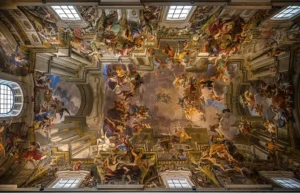
Next, we step into Sant’Ignazio di Loyola, a grand Jesuit church where Baroque art literally soars to new heights. Look up at Andrea Pozzo’s illusionistic fresco on the nave ceiling – a tour-de-force of trompe-l’œil perspective. At first glance, the ceiling seems to open up into the sky, with St. Ignatius and missionary figures ascending heavenward amidst architectural columns and clouds. In reality, the “dome” above is completely flat – a painted optical illusion that has fooled many an eye. Pozzo spent years (1685–1694) crafting this Triumph of St. Ignatius fresco, using stretched perspectives so precise that the church interior appears to dissolve into a glorious vision of heaven. As you move to the marked spot on the floor, the 3D effect is at its most powerful. Our guide will unveil how this Baroque masterpiece celebrates the Jesuit spirit and achieves its magic through geometry and imagination. Sant’Ignazio’s awe-inspiring interior, with its marbled altars and faux dome, perfectly captures the Baroque architecture ideal – to inspire faith through wondrous spectacle.
The ceiling of Sant’Ignazio dazzles with Andrea Pozzo’s illusionistic fresco. A flat ceiling is transformed into a vision of the heavens, teeming with angels and saints. This grand Baroque artwork (1680s) is a triumph of perspective, symbolizing the ascent of St. Ignatius to glory. Visitors often gasp at the moment they realize the dome above is merely painted – a testament to Baroque illusion and ingenuity.
Sant’Andrea delle Fratte – Bernini’s Angels in a Hidden Gem:
Our path leads to Sant’Andrea delle Fratte, a lesser-known 17th-century church that holds Angels by Bernini and lovely Baroque decorations. Flanking the main altar are two exquisite marble angels sculpted by Gian Lorenzo Bernini – the Angel with the Crown of Thorns and the Angel with the Superscription. These angels were originally carved for Rome’s Ponte Sant’Angelo bridge, but deemed too precious to weather the elements and were moved here for safekeeping.
Their graceful poses and flowing robes showcase Bernini’s ability to infuse stone with life and emotion. As you admire their delicate features, notice how they seem to interact with the space – a quiet echo of the theatrical style we saw at the fountain in Piazza Navona. Sant’Andrea delle Fratte also features vibrant frescoes by Ludovico Gimignani (look for his Baptism of Christ in the Baptistery) and a beautiful dome designed by Borromini. This stop offers a peaceful pause and an up-close encounter with Baroque sculpture in an intimate setting.
“Dueling Designs” – Sant’Andrea al Quirinale vs. San Carlo alle Quattro Fontane:
In this unique portion of the tour, we’ll compare two Baroque churches that sit just a few blocks apart, each a masterpiece of a rival architect. Sant’Andrea al Quirinale, designed by Bernini, is a jewel-box of Baroque art and was considered by the artist to be one of his finest works. Its elegant pink and gold interior is oval in plan, with a high altar and dome that flood the space with light from hidden windows. Bernini’s trademark is theatrical harmony – you’ll see how architecture, sculpture, and painting blend seamlessly here, crowned by a glorious dome and cherubs that seem to descend from above. Just across the road, San Carlo alle Quattro Fontane (nicknamed San Carlino) presents a contrast in style by Francesco Borromini. This tiny church astonishes with its undulating facade and complex geometry – a bold statement of Borromini’s innovative genius. The interior is an architectural marvel: an intricate oval dome with a honeycomb of coffers and a layout that shifts and flows as you move. Borromini’s design breaks the classical rules with curves that ebb and flow, making the stone literally ripple with energy. As you stand in San Carlino’s chapel, you’ll feel the difference: Bernini’s space is like a grand theater set, while Borromini’s is an immersive, almost otherworldly play of form. Our guide will highlight each architect’s innovations – Bernini’s integrated artworks and Borromini’s daring concave-convex facade – giving you insight into a legendary rivalry that propelled Baroque architecture to its creative peak.
Santa Maria della Vittoria – The Ecstasy of Saint Teresa:
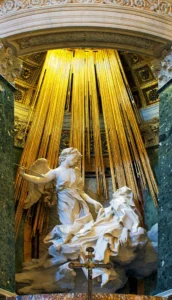
We end the tour on a breathtaking note at Santa Maria della Vittoria, home to Bernini’s Ecstasy of Saint Teresa. Tucked in the Cornaro Chapel of this small church, the sculpture is nothing short of a theatrical performance in marble. You’ll see Saint Teresa of Ávila carved in an exquisite moment of rapture, swooning on a cloud as a smiling angel aims a golden arrow – representing divine love – at her heart. Sunbeams of gilded bronze rain down behind them, illuminated by a hidden window above, as if spotlighting the climax of a stage play. Bernini, who also designed the surrounding stage-like chapel setting, achieved an emotional and sensory impact here that defines Baroque sculpture. The scene captures Teresa’s description of an intense vision of an angel, interpreted by Bernini with such sensual detail that some contemporaries blushed. Our guide will point out how the Cornaro family sculptures on the side (audience boxes in this theater of faith) lean in as if watching the drama unfold. This masterpiece, completed in 1652, brilliantly showcases the Baroque era’s passion for combining art, architecture, and light into one transportive experience. As you gaze at Teresa’s face – a mix of agony and ecstasy – you’ll understand why Baroque art is celebrated for its beauty, emotion, and drama.
Bernini’s Ecstasy of Saint Teresa (1647–52) in Santa Maria della Vittoria encapsulates the emotional and theatrical spirit of Baroque art. The sculptural group – lit by hidden light and framed by a proscenium-like chapel – draws viewers into St. Teresa’s mystical vision with its intense expression and dramatic use of light.
An Unforgettable Baroque Journey
This Rome Baroque tour is an immersive walk through the 17th century, connecting you with the city’s most evocative art and architecture. From bustling piazzas to hushed chapels, each stop reveals a different facet of Baroque genius – playful fountains, illusionistic frescoes, emotive sculptures, and revolutionary paintings. Our engaging guides weave together the history and anecdotes of each location, making the tour accessible and fascinating for both seasoned art lovers and curious travelers. You’ll come away not only with stunning photos, but with a deeper appreciation of how Rome’s Baroque masters – Bernini, Borromini, Caravaggio, and more – infused stone and paint with life, movement, and emotion. Join us on this vivid adventure into Baroque art and architecture and witness firsthand the grandeur and passion that have made Baroque Rome a must-see cultural experience.
Why Choose Crucis Tours?
At Crucis Tours, we believe in pilgrimage through beauty. Our Rome Baroque tour is more than a history lesson — it’s an invitation to encounter divine artistry in its most glorious form. With expert guides, sacred storytelling, and a pace designed for reflection, we offer travelers the chance to walk through living theology carved in stone and painted in light.
Whether you are a student of art, a lover of sacred architecture, or simply a seeker of truth and beauty, join us for this unforgettable journey through Baroque art in Rome.
Book your place today and encounter the glory of the Eternal City — one masterpiece at a time.
| MEETING POINT | Outside the Embassy of Brazil in Piazza Navona. See the precise location on Google Maps or What3Words. |
||||
| FINISHING LOCATION | Basilica of Our Lady of Victories (Santa Maria della Vittoria) | ||||
| DEPARTURE TIME | 9am Saturdays | ||||
| DURATION | Approx. 3 hours | ||||
| DRESS CODE | Comfortable clothing, covering shoulders and knees | ||||
| INCLUDED |
|
||||
| NOT INCLUDED |
|
Additional information
| Ticket Type | Adult (16+), Student ID, Child (under 16) |
|---|
Piazza Navona: Bernini’s Fountain & Borromini’s Façade
We begin our Baroque Art & Architecture Tour in the grand Piazza Navona, where two Baroque masters, Gian Lorenzo Bernini and Francesco Borromini, defined a generation. Your guide will introduce you to the dramatic symbolism of Bernini’s *Fountain of the Four Rivers*, whose marble figures personify the great rivers of the world. Facing the fountain is Borromini’s dynamic façade of Sant’Agnese in Agone, a masterpiece of concave elegance and vertical rhythm, showcasing the spiritual theatricality that marks Baroque architecture.
Sant’Agostino: Pilgrims’ Feet and Sacred Realism
Our next stop is the Church of Sant’Agostino, a hidden gem that houses Caravaggio’s *Madonna di Loreto*, also known as the Pilgrim’s Madonna. This moving painting captures barefoot pilgrims in adoration before the Virgin, portrayed with raw humanity and sacred dignity. Your guide will explore how Caravaggio’s radical realism and play of light embody the power of Baroque art to reveal holiness in the ordinary.
San Luigi dei Francesi: Caravaggio’s St. Matthew Cycle
We then walk to San Luigi dei Francesi to witness Caravaggio’s extraordinary triptych dedicated to St. Matthew: *The Calling*, *The Inspiration*, and *The Martyrdom of Saint Matthew*. These three paintings, bathed in shadow and pierced by divine light, transformed sacred storytelling through chiaroscuro and movement. Your guide will explain how Caravaggio broke from tradition to create emotionally gripping works that still command awe centuries later.
Sant’Ignazio: Heaven on a Flat Ceiling
Next, we enter the majestic Jesuit church of Sant’Ignazio di Loyola, home to Andrea Pozzo’s astounding illusionistic ceiling. From the marked viewing spot on the floor, you’ll gaze up to see *The Apotheosis of St. Ignatius* — a flat ceiling transformed into a heavenly vision of saints, angels, and celestial glory. Your guide will reveal the mathematical brilliance behind this visual marvel and explain how Jesuit spirituality shaped its message and design.
Sant’Andrea delle Fratte: Bernini’s Angels and Baroque Harmony
We continue to Sant’Andrea delle Fratte, a quiet sanctuary that houses two of Bernini’s exquisite angels originally crafted for the Ponte Sant’Angelo. These graceful sculptures — *Angel with the Crown of Thorns* and *Angel with the Superscription* — seem to float above the altar, their forms imbued with emotion and movement. Your guide will also point out frescoes by Ludovico Gimignani and highlight Borromini’s elegant dome.
Sant’Andrea al Quirinale and San Carlo alle Quattro Fontane: The Baroque Duel
Our tour then moves to two nearby masterpieces from Rome’s great architectural rivalry. At **Sant’Andrea al Quirinale**, Bernini’s oval sanctuary dazzles with gold light, symmetrical grace, and a central dome drawing the eyes upward in adoration. Just steps away lies Borromini’s **San Carlo alle Quattro Fontane** — a jewel of innovation with a rippling façade and honeycombed dome. Your guide will compare these two visions of sacred space, revealing how competition pushed both artists to their creative zenith.
Santa Maria della Vittoria: The Ecstasy of Saint Teresa
Our final destination is the Church of Santa Maria della Vittoria, home to Bernini’s iconic sculpture *The Ecstasy of Saint Teresa*. Set in the Cornaro Chapel like a celestial theatre, this masterpiece captures the saint in rapture as an angel’s golden arrow pierces her heart. With hidden light pouring in from above
Outside the Embassy of Brazil in Piazza Navona.
See the precise location on Google Maps or What3Words.



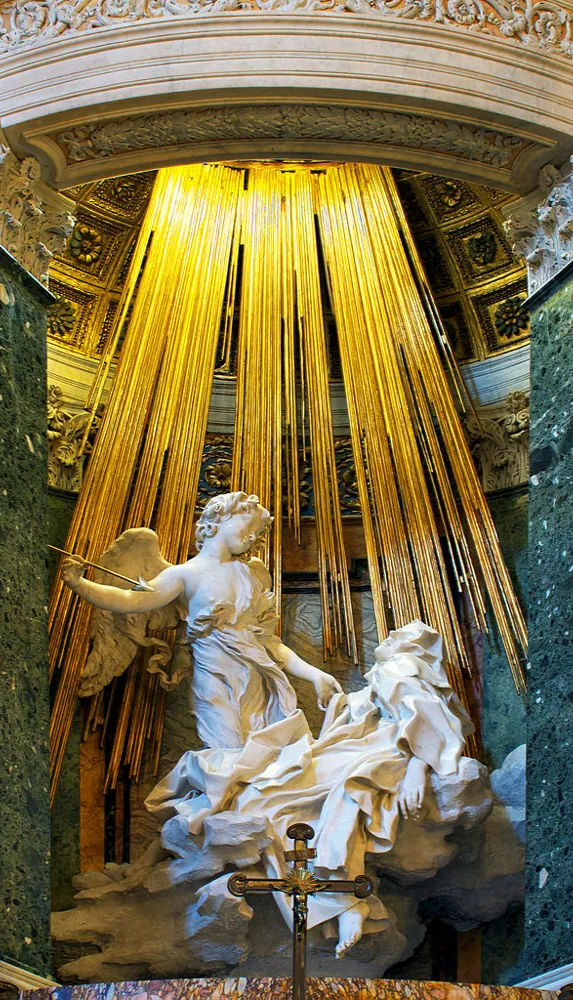
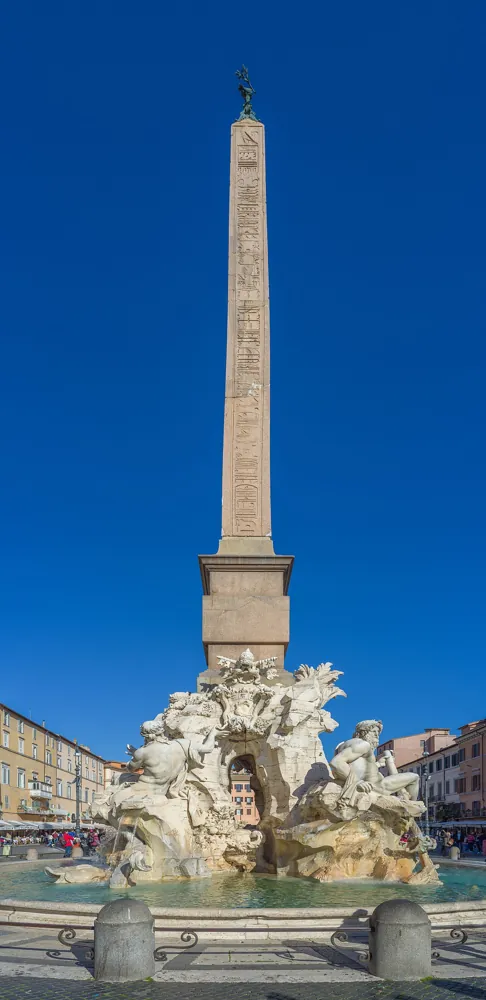
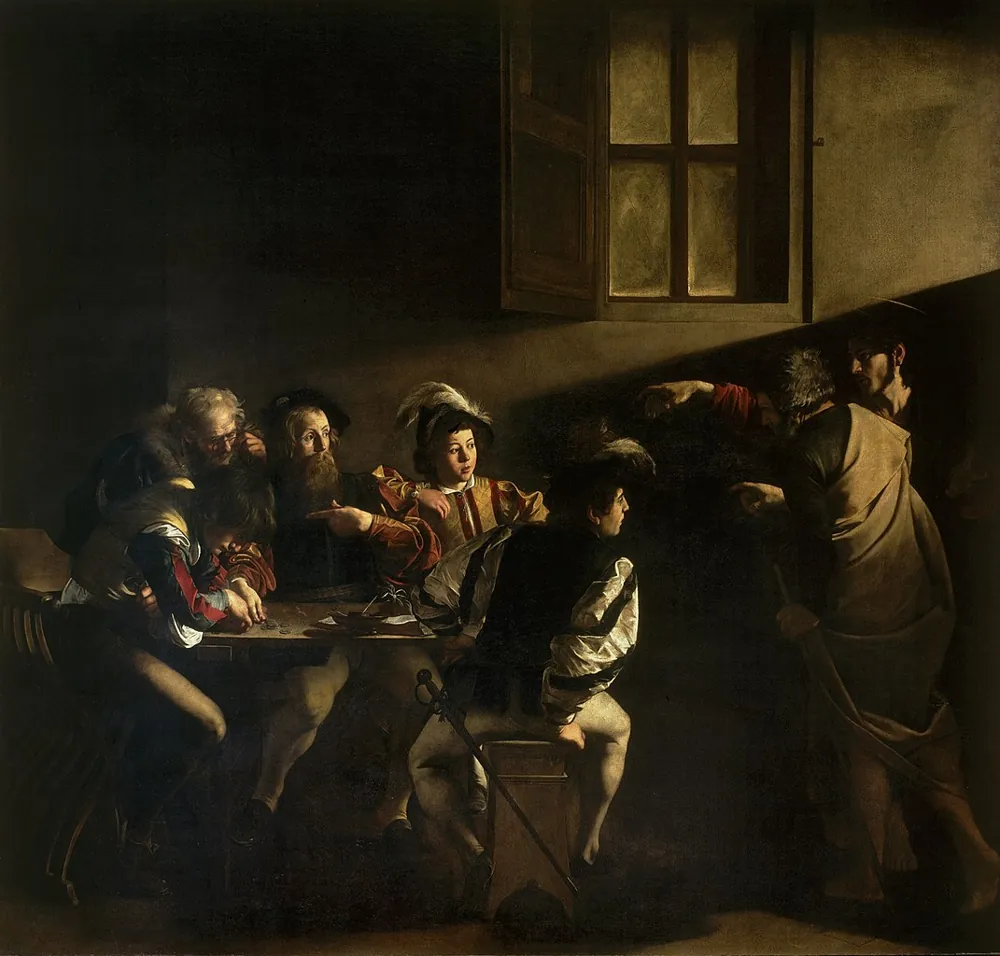
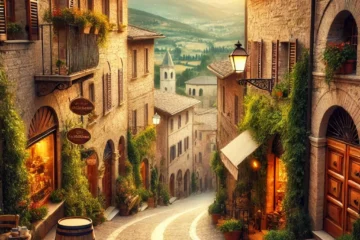
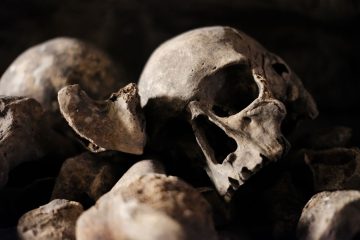
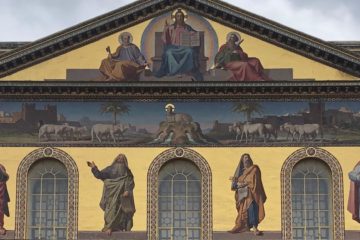
Tour Reviews
There are no reviews yet.
Leave a Review